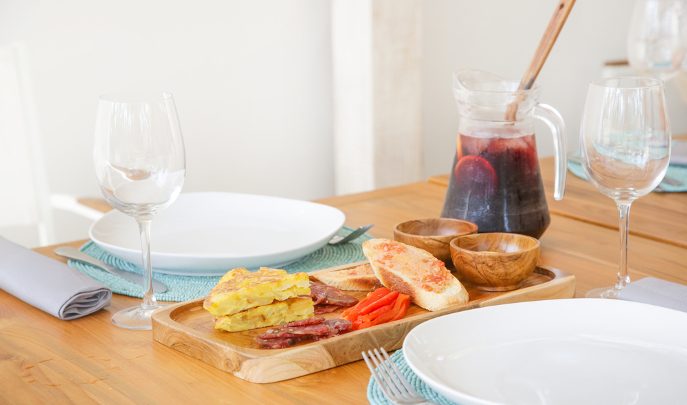The Starter, Main Course And Dessert Approach Isn’t The Only Way To Serve Up Delicious Lessons

Tapas teaching can offer a number of small engaging dishes for your students and leave them hungry for more

- by James Clements
- Writer, researcher and independent English adviser Visit website

I’m lucky enough to have a job that takes me to visit schools all over the country. Each year I’m invited to watch skilful teachers working in their classrooms, teaching wonderful lessons that inspire, challenge, educate and enlighten. And yet, from Cornwall to Cumbria, the excellent teaching that I see so often falls into a familiar pattern: the three-part lesson.
Of course, there’s no reason a lesson shouldn’t be organised in this way; it’s a tried-and-tested model, but it isn’t the only model.
As teachers it’s important to remember the freedom we have to organise our teaching as we see fit. The National Strategies, which did so much to embed the three-part lesson in schools, have been ‘archived’ (in other words, hidden on a particularly obscure part of the internet where it’s impossible to find the resources when you want them). Add to this Ofsted’s decree that inspectors are not looking for a particular style of teaching and it looks like teachers have plenty of freedom to structure things how they wish.
So, if a three-course-meal approach isn’t always the best way to structure a lesson, then how might teachers create a different type of menu for their children?
The tapas meal
This is a teaching session comprising a menu of small, engaging dishes. Each element might only last five or 10 minutes, and contain a mixture of direct teaching and modelling, children’s talk and discussion, independent work and practice or the teacher asking questions or giving feedback. The idea is to present children with an engaging series of activities, all based on the same lesson objective, but approaching it in different ways.
For example, a maths lesson about calculating fractions might begin with 10 minutes of teacher talk introducing the concept, immediately followed by a short task to see if children can do it independently. While the class get on with the task, the teacher can work with an individual or group, addressing any misconceptions. Students might then feedback to the teacher so she can make a judgement about what to do next.
In this case, the teacher introduces fractions with the denominator of 100, leading into a quick revision session about percentages. The children then work with a partner to solve some problems that involve calculating fractions and percentages. After this, the whole class work together to solve a real-life, open-ended problem featuring fractions in a recipe. Finally, the teacher asks the children to work independently to solve a similar problem, allowing her to assess what they can do.
This model is great for embedding formative assessment within the teaching cycle, with a teacher’s observation and the feedback she collects determining whether the class are ready to move on to something more complicated, or if they need to look at the same content in a slightly different way to ensure they’ve understood it.
The feast
This is the opportunity to spend an extended amount of time focusing on just one thing.
Traditionally, this has been the model used for extended writing, with weekly or end-of-unit sessions lasting 45 minutes to an hour. But an opportunity to concentrate on one task for a whole session can be just as useful in other areas of the curriculum.
At the end of a unit of work about sculpture, focusing on the work of Henry Moore, children had an extended opportunity to demonstrate what they had learnt.
The unit began by looking at some of Moore’s sculptures and thinking about how his style developed over his career, followed by a trip to a country park to see one of his sculptures first-hand. After a series of art lessons learning about different techniques used in clay sculpture, each with an opportunity to try out that practical technique, the class were given a 45-minute session in which to create their own sculpture.
The teacher went round the room, offering feedback, support and advice to individuals. Once the sculptures were completed and fired, there was an opportunity to evaluate them, but in this session there was no introduction (that was covered in other sessions) and no plenary (which came later). There was simply the chance for children to put what they’ve learned into practice.
The dinner party
This is the chance to slow down and take some time to talk about a topic in depth. The talk could be organised as a whole-class exercise, in groups with a specific task, or with a partner. The emphasis is on discussion and debate, rather than talking, so it can lead to an immediate written outcome.
In a lesson exploring how authors present information about a character through dialogue and action rather than description, the class are reading Macbeth from Leon Garfield’s Shakespeare Stories.
The children have a copy of the text between two, while the teacher and different members of the class take in turns to read aloud. The group then stops to discuss particular passages, sentences or even the meaning of individual words. Periodically, the teacher stops to directly clarify something, to ask a question or to discuss a particular point.
During the session, one child expresses the opinion that Lady Macbeth is the driving force behind his actions and that she’s the real reason King Duncan has been murdered.
Another disagrees and suggests the witches were the cause. This leads to whole-class discussion about who is to blame for King Duncan’s death.
Children are encouraged to express their opinion and justify it based on the story. Eventually, this leads to a written outcome (some writing in role) but for this session, the focus is on oracy.
Starter, main course, dessert
Of course, sometimes a three-part format is exactly the right way to structure a lesson. The opportunity to introduce a concept, allow children to show they can do it, then check their understanding through a plenary idea can be a brilliantly effective model. But this isn’t set in stone.
As long as the children have the opportunity to learn something new, consolidate something they’ve learnt previously or apply their learning to new area, it doesn’t matter how the lesson is structured. As teachers, we’re free to serve up learning in any form we wish.
SOLID STRUCTURE
Six questions to ask when lesson planning: 1. What do I want the children to learn / apply / practice in the session? How does this affect the way the lesson needs to be structured?
2. What do the children know about this area already? How do I know?
3. What will be the outcome of the session? Does there need to be an outcome at the end or could today’s learning feed into future work?
4. How will I feedback to children about their work? How will they feedback to me about what they’ve learnt?
5. How can I ensure that all children are challenged and have the chance to achieve in the session?
6. Are there any additional opportunities for learning or developing additional skills? Oracy? Working as a team? Reading? Writing? ICT?
James Clements is an education writer and researcher. Find him on Twitter at @James_ShMore.










